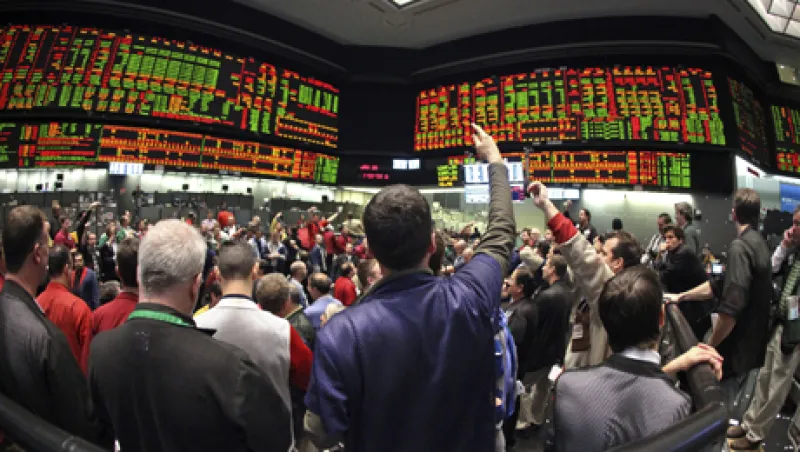The Americans are coming — and derivatives trading in Europe may never be the same. In late August the largest U.S. futures exchange operator, Chicago-based CME Group, unveiled plans to launch a London-based derivatives exchange in the heart of the city’s financial district, known as the Square Mile. Although the new bourse, CME Europe, isn’t expected to go live until the summer of 2013 pending regulatory approval, the decision to challenge European incumbents — NYSE Euronext’s Liffe and Deutsche Börse’s Eurex — signals a new competitive salvo in the coming battle for market share in exchange-traded derivatives.
Over the past decade the listed derivatives market in Europe has remained remarkably concentrated even as it has grown dramatically. The trading volume of European equity index futures and options reached 1.4 billion contracts in 2010, with a notional value of $52 trillion, according to research by Hamburg-based Berenberg Bank. Both figures represent a five-fold increase from 2000. Trading in European interest rate derivatives tripled over the same period to 1.2 billion contracts, while the notional value of those contracts was six times larger at $730 trillion.
With coming regulatory changes in Europe destined to standardize derivatives trading and to open clearing to greater competition, would-be challengers like CME Europe and the London Stock Exchange Group’s Turquoise Derivatives are positioning themselves to make a run at Eurex and Liffe. They’re not alone. Nasdaq OMX has announced plans to launch a new London-based trading venue, NLX, in early 2013 to offer trading in listed short- and long-term interest rate derivatives. London-based interdealer broker ICAP has also indicated that it could move into listed derivatives trading with its recent strategic acquisition of the loss-making London-based operator Plus Stock Exchange.
CME Group isn’t taking any chances as it positions its new business. The massive, diversified global futures and options exchange operator, which has a market cap of $18.4 billion, is planning to introduce forex futures as its first asset class, not least because that particular market — although admittedly small — is one that the CME already dominates. According to the most recent market data collected in 2010 by the Bank for International Settlements, just 4 percent of the $4 trillion in average daily value traded on global FX markets across a range of derivatives products is conducted on-exchange; the remainder is traded over the counter. But of that 4 percent, which equals about $170 billion in daily trading value, CME Group conducts the lion’s share of the business, says Richard Perrott, a London-based analyst who covers diversified financials for Berenberg.
“CME is the center of FX derivatives trading and always has been,” he says. “But there is a huge amount of trading transacted over the counter, and that is a much bigger percentage of the market — and changes are coming to that space. More products will be standardized and cleared, and CME is positioning itself to have a London base, which may help the exchange attract liquidity and build more open interest.”
The decision to launch with listed FX derivatives will also help differentiate the nascent CME Europe’s efforts from those of its nearest rivals, Liffe and Eurex. Perrott points out that neither of the European incumbents does much business in listed currency derivatives. Liffe dominates interest rate derivatives markets in Europe; Eurex is equally strong in equity index derivatives and those based on sovereign bonds. In the near term, CME Europe’s strategy is to carve out its own niche and innovate in a familiar space. The decision to base the new exchange in London is also strategic, since some 65 percent of all global forex trading takes place in the city, according to CME Europe’s new CEO, Robert Ray.
“Putting the exchange here made sense because we needed to be closer to our end users — and we wanted to put additional focus on clients who may be underserved by current product offerings,” he says. “We already have excellent product coverage in the G7 through G10 countries, but we will now start to look at Scandinavian and Eastern European countries, too, to see what we might be able to do better.”
Ray, 59, joined the parent company, CME Group, from the Chicago Board of Trade after the merger of the mega-exchanges in 2007 and moved to London in 2009 as head of international business to help develop the parent group’s regional strategies in Europe, the Middle East, Asia and Latin America (CME Group has had a presence in London for three decades). He has long been focused on developing new business strategies — and will need to be an innovator if CME Europe is to challenge the incumbents, given the difficulties and costs associated with organizing clearing arrangements for clients. But the new derivatives exchange will have the benefit of its own, dedicated clearing facility thanks to CME Group’s decision to launch a European clearing business, CME Clearing Europe, in May 2011.
For CME Group, international expansion may be the only strategy available now that the company has virtually maxed out its growth potential in the U.S., where it dominates futures trading across a range of asset classes. Approximately 80 percent of the parent company’s trading volume is derived from its operations in North America but the balance is gradually shifting as CME focuses on developing new business relationships overseas. In the fourth quarter of 2011, for example, some 15 percent of CME Group’s trading volumes were generated by business activity outside the U.S.; by the first quarter of 2012, that percentage had risen to 17 percent, and it continues to climb. CME Europe will now become a major focus of new business development, according to Ray. “We’re entering a new phase of pushing out our international platform,” he says, “but — instead of reinventing the wheel — we have the opportunity to leverage CME Group’s resources and scale up.”
Greater geographic diversification will be key to the exchange operator’s future. Based on metrics released on Wednesday, CME Group struggled in August, as total trading volume dropped by 40 percent year-over-year, to an average of 10.3 million contracts per day, down 40 percent from an all-time record in August 2011 when high market turbulence caused trading to spike. CME Group cannot afford to lose ground over time — but the coming regulatory push to drive more trading on-exchange may help. Total volume for August 2012 was more than 237 million contracts, of which 86 percent was traded electronically.
Given the roadblocks that several major exchanges encountered while trying to carry out vast, complex international mergers over the past year, organic growth in new markets may be far easier to achieve than any individual acquisiton. In February Deutsche Börse and NYSE Euronext’s proposed merger failed spectacularly when the European Commission voted to block the $7.4 billion deal. In July CME Group, which had sought to expand its European footprint by bidding for the London Metal Exchange, saw its hopes dashed when shareholders and members voted to sell the venerable exchange to Hong Kong Exchanges & Clearing for £1.39 billion ($2.2 billion). For the moment, CME Group is pursuing strategic growth by other means, Ray says, such as forging strategic partnerships, like the decision in February to hike its stake in the Dubai Mercentile Exchange to 50 percent.
Make no mistake, however. Europe is now a key market for the world’s largest exchange operator. About 125 staff now work in CME Group’s London offices on New Change Street; the company plans to add up to 100 staff in Belfast by the end of 2013. Once CME Europe launches next summer, Ray says, its closest rivals can expect to see the new business expand beyond forex futures to encompass options, as well, and he fully intends to lead the new business in a steady, strategic process of asset-class diversification in the months and years to come.






